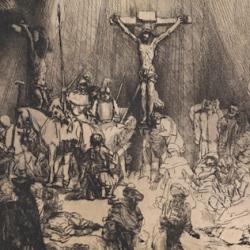Jenson gives a concise summary of the weaknesses of traditional atonement theories (Theology as Revisionary Metaphysics, 128-30). There are “two paired errors.”
The first separates the cross “from its future, in the resurrection.” As Jenson says, without the resurrection, the “in the Bible’s general view of reality, a crucifixion would be anything but beneficial.” The apostles don’t talk about the cross without its future; their message is, “Jesus was put to death by the hands of sinful men, but God raised him up; therefore a return to God and life in his Spirit are open to you.” Jenson thinks Anselm is better than some of his critics has suggested, but his “doctrine does have a fatal flaw” with regard to the resurrection. For Anselm, “God and humanity are reconciled with Jesus dies, and the Resurrection tidies up.”
Equally, the tradition has tended “to sever the cross from its past in the canonical history of Israel.” This deletion runs deep: “Both the early rules of faith and the baptismal and conciliar creeds that developed from them skip straight from Creation to the Incarnation, leaving out the whole of the Lord’s history with Israel. . . . for all the Creed’s display, the Creator could just as well have sent his Son to reunited humanity with himself, without having called Abraham, or having led Israel from Egypt, or having dwelt in the temple, or having sent Israel into exile and having – sort of – brought them back, or indeed, without having done any of the works described in the Old Testament after the first chapter of Genesis.”
Jenson is dismissive of penal accounts of the atonement, and that’s a mistake. Otherwise, his critique of atonement theory is right on target.














